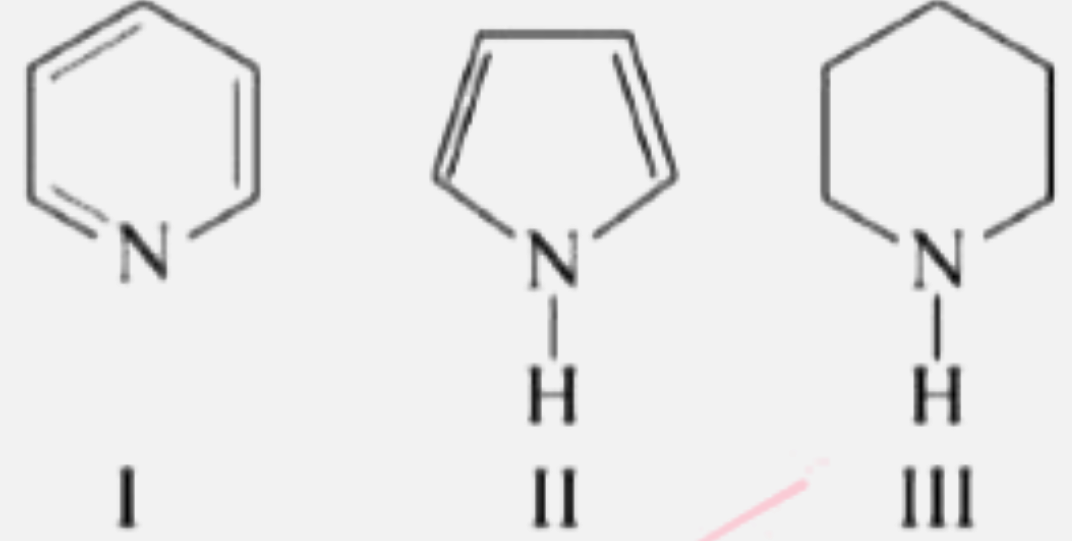Amines are derivatives of ammonia and are classified as Primary and secondary (but not teritary amines) form intermolecular hydrogen bonds and thus they boil at higher temperature than expected.Like ammonia, all amines are basic, although they differ in their basic nature.As amines are considered as derivatives of ammonia, quatemary ammonium salts are considered as derivatives of ammonium salts.Only the quatemary ammonium salts can show optical activity.
Which of the following statement is correct ?
All classes of amines form hydrogen bonds with each other
Only primary and secondary amines form hydrogen bonds with
water
All classes of amines can form hydrogen bonds with water
All amines are completely soluble in water
The correct Answer is:C
To solve the question regarding the properties of amines and their classification, we will analyze each statement provided and determine which one is correct.
1. Understanding Amines:
- Amines are derivatives of ammonia (NH₃) and are classified into three categories: primary (1°), secondary (2°), and tertiary (3°) amines.
- Primary and secondary amines can form intermolecular hydrogen bonds due to the presence of hydrogen atoms attached to the nitrogen atom.
2. Analyzing the Statements:
- Statement 1: "All classes of amines form hydrogen bonds with each other."
- This statement is incorrect. While primary and secondary amines can form hydrogen bonds, tertiary amines do not have hydrogen atoms attached to nitrogen and thus cannot form hydrogen bonds with each other.
- Statement 2: "Only primary and secondary amines form hydrogen bonds with water."
- This statement is also incorrect. Although primary and secondary amines are more capable of forming hydrogen bonds with water, tertiary amines can also interact with water through dipole-dipole interactions, although they do not form hydrogen bonds in the same way.
- Statement 3: "All amines are completely soluble in water."
- This statement is incorrect. While many aliphatic amines are soluble in water due to hydrogen bonding, aromatic amines (like aniline) are less soluble due to their larger hydrocarbon portions which hinder hydrogen bond formation.
- Statement 4: "Only quaternary ammonium salts can show optical activity."
- This statement is correct. Quaternary ammonium salts have a positively charged nitrogen atom bonded to four different groups, which can lead to chirality and thus optical activity.
3. Conclusion:
- The correct statement among the options provided is Statement 4: "Only quaternary ammonium salts can show optical activity."
- Amines are derivatives of ammonia (NH₃) and are classified into three categories: primary (1°), secondary (2°), and tertiary (3°) amines.
- Primary and secondary amines can form intermolecular hydrogen bonds due to the presence of hydrogen atoms attached to the nitrogen atom.
- Statement 1: "All classes of amines form hydrogen bonds with each other."
- This statement is incorrect. While primary and secondary amines can form hydrogen bonds, tertiary amines do not have hydrogen atoms attached to nitrogen and thus cannot form hydrogen bonds with each other.
- Statement 2: "Only primary and secondary amines form hydrogen bonds with water."
- This statement is also incorrect. Although primary and secondary amines are more capable of forming hydrogen bonds with water, tertiary amines can also interact with water through dipole-dipole interactions, although they do not form hydrogen bonds in the same way.
- This statement is incorrect. While many aliphatic amines are soluble in water due to hydrogen bonding, aromatic amines (like aniline) are less soluble due to their larger hydrocarbon portions which hinder hydrogen bond formation.
- This statement is correct. Quaternary ammonium salts have a positively charged nitrogen atom bonded to four different groups, which can lead to chirality and thus optical activity.
- The correct statement among the options provided is Statement 4: "Only quaternary ammonium salts can show optical activity."
Topper's Solved these Questions
Similar Questions
Amines are derivatives of ammonia and are classified as 1∘,2∘,and3∘ Primary and secondary (but not teritary amines) form intermolecular hydrogen bonds and thus they boil at higher temperature than expected.Like ammonia, all amines are basic, although they differ in their basic nature.As amines are considered as derivatives of ammonia, quatemary ammonium salts are considered as derivatives of ammonium salts.Only the quatemary ammonium salts can show optical activity.
Methylethylpropyl amine is optically inactive because
View SolutionAmines are derivatives of ammonia and are classified as 1∘,2∘, and 3∘, Primary and secondary (but not teritiary amines) form intermolecular hydrogen bonds and thus they boil at highter temperatures than expected. Like ammonia, all amines are basic, although they differ in their basic nature.
As amines are considered as derivatives of ammonia, quaternary ammonium salts are considered as derivatives of ammonium salts. Only the quaternary ammonium salts can shown optical activity.
When nitrogen is bounded to three different groups
View SolutionWhich the following amines is the least basic ?

View SolutionPrimary, secondary and tertiary amines may be separated by using
View SolutionPrimary and secondary amines can be distinguished by
View SolutionPrimary and secondary amines are distinguished by:
View SolutionPrimary and secondary amines are distinguished by :
View SolutionThe decreasing order of basicity of the following amines is :

View SolutionCategory of compounds which liberate ammonia from ammonium salts :
View SolutionPrimary, secondary and tertiary amines cannot be distinguished by the action of
View Solution
